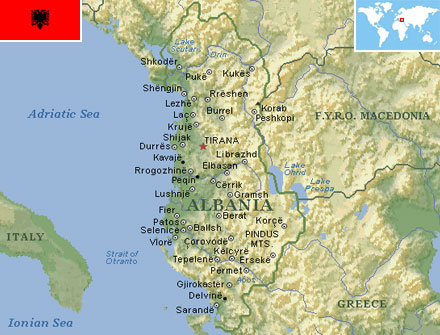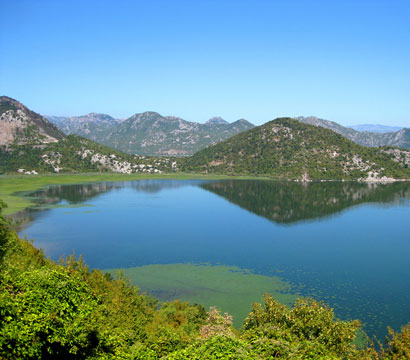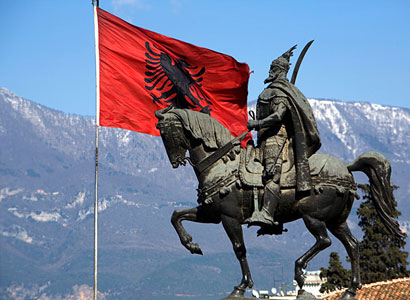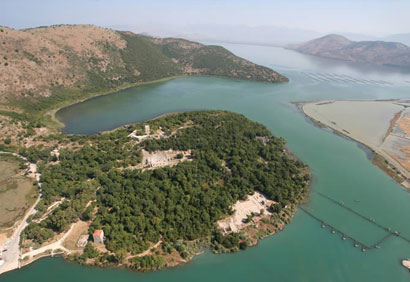Albania
Country statistics

Land area: 10,579 sq miles (27,400 sq km)
Total area: 11,100 sq miles (28,748 sq km)
Population (2010 est.): 3,659,616 (growth rate: 0.56%); birth rate: 15.39/1000; infant mortality rate: 17.5/1000; life expectancy: 78.13; density per sq miles: 340
Capital City: Tirana
Monetary unit: Lek
Languages: Albanian (Tosk is the official dialect), Greek
Ethnicity/race: Albanian 95%, Greeks 3%, other 2%: Vlachs, Gypsies, Serbs, and Bulgarians (1989 est.)
Religions: Islam 70%, Albanian Orthodox 20%, Roman Catholic 10% (est.)
Country introduction

Albania is a country in South-eastern Europe, bordered by Montenegro to the north-west, Kosovo to the north-east, Macedonia to the east and Greece to the south and south-east. It has a coast on the Adriatic Sea to the west, and on the Ionian Sea to the south-west. It is less than 72 km (45 miles) away from Italy, across the Strait of Otranto which links the Adriatic Sea to the Ionian Sea.
Mellow lowlands stretch along the coast, but the rest of the country is predominantly mountainous and jagged, with 70% of the territory at elevations of more than 300 m (984 ft) and making it inaccessible from the outside. The highest mountain is Korab situated in the district of Dibër, reaching up to 2,753 m (9,032 ft).
Albania has nearly 450 km (280 miles) of seacoast, with the Adriatic running from the Montenegrin border south to the Bay of Vlora, where the Ionian Sea begins. The Ionian Cost is very rugged with rocky coves along the narrow coastal strip and steep mountains rising almost straight up almost much of its length. The highest point along this stretch is at the Llogara Pass, over 1,000 m (3,300 ft) high.
The biggest lake of Albania and the Balkan Peninsula is the Shkodra Lake (also called Lake Scutari and Lake Shkodër) followed by the Ohrid Lake and Lake of Prespa. In the south is the Lake of Butrint and in the massif of Nezhda Mountains in the Dibra region there are 7 carstic lakes, Lakes of Lura, which are attractive for their natural beauties. The most important Rivers are Drin, Vjosa, Mat, Ishm, Erzen, Buna, Shkumbin Seman and Osum.
Around one third of the country is covered by forests which are mainly in the area between the main mountain ridge and the coastline.
The culture

The Albanians are one of the oldest races in Europe and they speak the oldest language. The first people to settle in Albania were the ancient Illyrians, which today are known as Albanians. Ancient Illyria included Albaniana, Montenegro, Croatia, Slovenia, Kosovo, Epirus, Serbia and Macedonia. When the Slavic tribes known today as Serbs, Croats and Slovenes migrated down to the Balkans they settled on ancient Illyrian soil. Albania is also a country with a very rich and old history and is home to both Mother Theresa and the great 15th century Albanian lord Skanderbeg, who fought against the Ottomons in the 1400's.
Two cultural groups exist in Albania, the Ghegs (Northern Albanians) and Tosks (Southern Albanians), with the Shkumbin River serving as geographical borderline between the two groups. The Ghegs, generally those of Kosovo, Montenegro and Macedonia, speak with typical nasalisation traits. The Tosks, mainly those in Greece, South-western Macedonia and Italy, speak with typical rhotacism traits. Although there are significant differences between the two cultural groups, they keep a strong national identity and ethnic culture. The traditional values among the people are family, and respect towards elders and strangers. Albanians are well known for their hospitality, and guests are treated with great respect.
Folklore is cherished by the Albanian people, and old stories and traditions are still passed down from parents to children. Fairies, snakes, and dragons are among the main figures in Albanian mythology. Characters in Albanian folklore include the kucedër (a snake or dragon with many heads), the shtrigë or shpriga (witch), and the stuhi (a flame-throwing winged being that guards treasures). Zana are mythical female figures who help mountain folk in distress. To call someone a kukudh is the ultimate insult, since it means "a dwarf with seven tails who can't find rest in his grave".
The Albanian people, like many other nations from the Balkans, consider traditional music, dance and crafts to be one of their most prized cultural possessions. Styles of music, dance, art and even folk dress differ according to region. Traditional dance is still widely practiced, especially in more remote villages but because of Islamic influences, especially in the south, women and men often do not dance together in public. The most common traditional instrument is the lahute (lute), which is similar to the Slavic gusle. Also in the south, saze (small orchestras) composed of four or five instruments play music for folk dancing on special occasions.
Albanian cuisine draws on Turkish, Greek and Italian influences and include dolma, a traditional dish made of grape leaves stuffed with rice, and the baklava, a dessert inherited from the Turks, made of thin layers of dough filled with nuts and doused in syrup.
Attractions & landmarks

The natural beauty of the land, the numerous world heritage sites, museums, cities with lively nightlife and the welcoming attitude of the people make Albania a perfect holiday destination.
The most notable tourist attractions are the ancient sites of Apollonia, Kruja and Butrint. Butrint in particular is considered the largest archaeological site from the Greek, Roman and Byzantine periods and is remarkably well preserved. Here a Roman amphitheater, a Byzantine basilica (the second largest in the world), and a Roman temple can be seen.
Albania's coastline with the Adriatic Sea has become increasingly popular with tourists due to its relatively unspoiled beauty and amazing natural white sand beaches. Some examples of the best beaches include Shëngjini Beach, Spille Beach, Palasë Beach and Golemi Beach. The Albanian Riviera is undoubtedly one of the most beautiful and unspoiled regions in Albania. The Adriatic and Ioanian coast of Albania are of a dramatic beauty. The coastline stretches for over 450 km (279 miles) and features traditional Mediterranean villages, ancient castles, and Orthodox churches. The landscape alternates between mountain passes, turquoise beaches, underwater fauna, caves, and orange, lemon and olive plantations. Additionally, the deepest lake in the Balkans, Lake Ohrid is a popular destination due to its diversity of flora and fauna. The lake reaches depths of over 900 feet and is connected by underground channels flowing south-east to Lake Prespa. Renowned for its fishing and beaches, the lake has an area of over 130 square miles, and several quaint and idyllic towns, including Pgreded, Peshtani and Trpejca rest along its borders.
The capital city of Tirena, founded in the 12th century by the Turks, is a small hive of culture and history best explored on foot. There are plenty of ancient landmarks to see including mosques, churches, bazaars and water fountains that were often built near Mosques by the Ottomans as a gesture of good will to the people. Some of the main destinations in the place are the Fan noli statue, National History Museum, Tanner Bridge and Skanderbeg museum. To escape the busy capital, inhabitants can take a trip to Mount Dajti, just east of the city. In the summer, the lush forests of Mount Dajti are very cooling, while during the autumn season people crowd to the slopes of the mountain to see snow (which rarely falls in Tirana).

The mountain range called Prokletije Mountains (or Albanian Alps) which extends from Northern Albania, to South-western Serbia and Eastern Montenegro is a perfect place for hiking and walking and for adventurers seeking solitude. The mountain range is known for the rich variety of its flora and fauna and for the Thetit National Park. The highest peak of the Albanian Alps is Maja Jezerece with height of 2,694 m (8,838 ft) and is the second highest in Albania.
Durrës the second largest city of Albania located on the Central Albanian coast is one of the most ancient and economically important cities of Albania. There are traces of Byzantine and Turk influences in many of the architecture in the area. Having a capacity of 20,000 people, the Amphitheater in Durrës is one of the largest amphitheatres in the Balkan Peninsula. Built in the 2nd century BC, during the Roman rule, it stands among the largest monuments of the Antiquity.